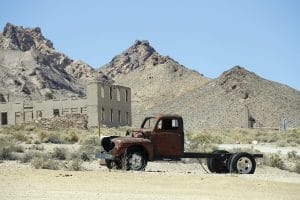Story by Will Shiers
The typical tourist traps of America’s wild west include the Disney World, the Empire State Building, the Las Vegas strip, the Grand Canyon, Yosemite National Park and Hollywood. It is these places that create the image of America’s wild west for most. Give it a miss however and a different world beacons. It is a world where a history in tin-hunting could be carved out. Lying beyond big cities and interstates, and in the boondocks on two-lane blacktops, the America’s wild west is where abandoned vehicles are found – abandoned trucks are found. In barns, fields, ghost towns, deserts and junkyards. Spread thin and thick through 50 states as an effort is made to explore them without being stung, shot, stabbed and bitten. Photographing such American roadside relics is a revelation. Here’s some of them from a 3000-mile roadtrip through California, Nevada, Idaho, Washington and Oregon.
This 1944 FWD SuCOE is one of 2700 4×4 6-tonne trucks built for the US Army Ordinance Department by the Four Wheel Drive Auto Company (FWD). Capable of carrying heavy loads over rough terrain, they saw active service in Europe and Russia during WW2. This right-hand-drive example, which has a machine gun turret in its roof, resides in a junkyard in Mountain Home, Idaho. Although it hasn’t turned a wheel in two decades, incredibly it still holds air in all four tyres. The engine and radiator have long since gone, but the transmission and drivetrain are still in place. Fancy such an interesting, largely rust-free restoration project, head over to Idaho with USD 3500.
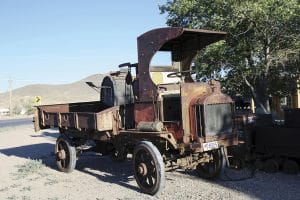
It would be fair to say that this 1940s Chevy truck has a face that only a mother could love. Except for the Ford Otosan Cargo in fact, this truck could be the most aesthetically challenged truck ever! Photographed in an old Nevada ghost town called Gold Point, which as the name would suggest, was once a gold mining town, the Chevy truck most likely spent most of its working life servicing the mines. The mines remained in operation until the 1960s. Please note the bullet holes in the passenger door of the truck.

Just how this 1960s Ford Econoline ended up in this condition, abandoned in the Nevada desert, miles from civilization, is anyone’s guess. Seeing as there’s nothing much to do in Nevada (except gambling, drinking and prostitution of course), the bored locals seem to use any dumped vehicle as a target practice. This van is so riddled with bullet holes that it’s starting to resemble an alopecic hedgehog!
Photographed in a junkyard in northern California, this Mack AC ‘Bulldog’ is a real rarity. The AC model, with its distinctive snub nose design, was built for the military, and first went into production in 1916. With its chain-driven rear axle, the truck proved to be unstoppable in arduous conditions, and quickly developed itself a reputation for reliability on Europe’s battlefields. The AC actually got its bulldog nickname from the British troops, who reckoned it had the appearance and tenacity of a bulldog. Of course, the truck maker would later go on to adopt the bulldog as its official mascot. By the time production ceased in 1939, some 40,000 ACs had been built. (Pic 4.)
All American Classics of Vancouver, Washington, has had a massive cull recently. Ever-increasing property taxes forced the salvage yard to sell-off 14 acres or its 20 acres. This resulted in the crushing of 1200 classic vehicles. Fortunately, this wonderful 1950s White 3000 wasn’t one of them. (Pic 5&6.)
Ford’s once-ubiquitous C-series is fast disappearing from America’s roads. There’s still plenty of them in salvage yards. The one in this picture was spotted in Turners Auto Wrecking of Fresno, California. The cab it sports was used by at least four other truck makers during its time, including the Mack, FWD and Canadian fire truck specialist Carl Thibault. Despite being in production for 33 years (1957 to 1990), the Ford C series isn’t the longest-built truck in America. That accolade goes to the Kenworth W900, which is still rolling off the line after 57 years.
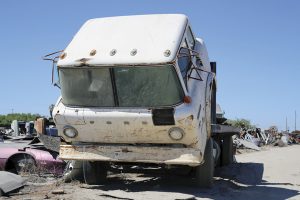
Rhyloite, Nevada, 120 miles north-west of Las Vegas, is a true ghost town. Gold was discovered there in 1904, and two years later an estimated 5000 people called it home. But when the gold ran out, so did the people, and by 1920 the place was deserted. Today the town still has some fantastic stone ruins, including the old school that can be seen in the background, behind the late 1940s Ford truck in the picture. The American ghost town of Goldfield, Nevada, was home to 20,000 people at its peak in 1906. It boasted the largest hotel west of the Mississippi (which is still standing today). Its famous residents included Wyatt and Virgil Earp. It had schools, theatres, countless bars and a thriving red-light district. Today, post numerous floods and fires, the place is a shadow of its former self. Some 200 people still live there though, and the vast majority have at least a handful of abandoned cars or trucks on their properties. The one among them to catch attention is a now rare Model TT. It probably dates to 1924; has wooden wheels, and is surrounded by other abandoned stuff like the old railway carriage behind it.
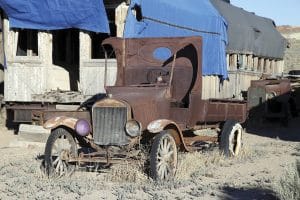
In Vancouver, Washington, there’s a classic truck that escaped and it was lucky to escape the crusher’s jaws. It is a 1952 Autocar U-series COE. Starting to build cars (Brass Era automobiles) in 1897, Autocar took to trucks in 1899. It is today the oldest surviving motor vehicle brand in the western hemisphere. Building mainly heavy-duty trucks for the refuse, mining and construction sectors, Autocar is today a leader in in several vocational segments. This truck in the picture was purchased by a collector in Sacramento, California, soon after it was photographed. It’s not uncommon to find an old truck rotting away in a far-flung corner of a UK haulier’s yard. They’re generally kept for sentimental reasons, with the false belief that one day they’ll be restored. But instead, every year the tin worm feast on them, until eventually, they’re well past saving. It’s a different story in America’s desert states though, where vehicles can sit outside in the elements for decades without coming to any harm. This original FWD is a perfect example. It’s over 100 years old, yet has nothing worse than the surface rust. A 1917 manufactured vehicle most likely, the Model B 3-tonne truck could be one of the 14,000 units delivered to the US Army to help in the European war effort.
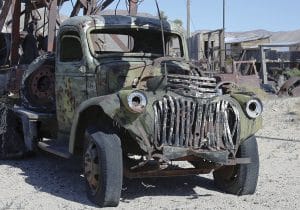
Here’s a retired workhorse that travelled the world, before finally being put out to pasture in a Nevada ghost town. It’s a 1950s FWD HST-COE, and was originally built for the US Coast Guard. During its years of active service, it would have helped to build and maintain electric power and telephone communication pole lines in the South Pacific. In its second life it was purchased and used by a Californian water well drilling company. The homemade wooden bumpers, it would be safe to assume, were added during this stint.
In 1864, a prospector exclaimed “Eureka” upon discovering silver deposits in a mountainous region of central Nevada. The town of Eureka thus got its name. Situated on US50, a 3000-mile road that starts in Ocean City, Maryland, on the east coast, and finishes in Sacramento, California, in the west, Eureka is where this beautiful 1941 K4 International pickup truck was found parked-up outside an abandoned hospital. Interestingly, the 4,828 km US50 passes through 12 states, and the Nevada leg is known as ‘The Loneliest Road’ in America.
Cabovers were once hugely popular in the United States. They began to lose favour in the late 1970s when length law restrictions began to ease up. Pictured here is a 1980s Freightliner, complete with a trailer, at a bus graveyard in Williams, California.
……………………………………………………..
CV is an associate member of the International Truck of the Year (IToY). As part of this association, the magazine provides exclusive articles, written especially by IToY jury members.



